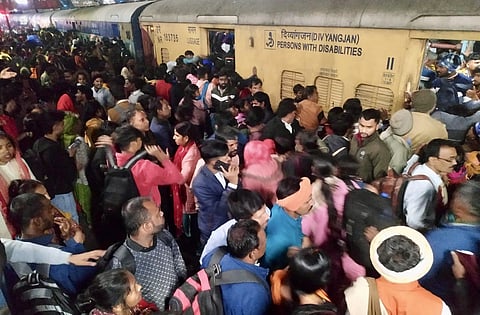India needs a national crowd management campaign, not just a policy
To prevent stampedes, it is not enough to make policies but to see them implemented

This month we have seen two stampedes in India causing regrettable loss of lives. One was at the Kumbh Mela, known as the largest gathering of humanity in the world.
The other was at the New Delhi Railway Station, partly because of the greater-than-usual crowds of people trying to take a train to the Kumbh Mela. Last month, a stampede at Tirupati temple in Andhra Pradesh took six lives.
No, it is not a good idea to say stampedes are inevitable sometimes in crowded places in one of the world’s most densely populated countries. India can and does achieve things at great scale when it does them in ‘mission mode’, whether it is vaccinating tens of millions of people or organising elections without violence and rigging — or stampedes.
In 2014, the National Disaster Management Authority came up with a crowd management policy that goes little beyond basic guidelines. We need a long list of SOPs, standard operating procedures, that should be made available to all government and private authorities managing crowds, whether at fixed places like railway stations and temples, or at temporary events like the Kumbh Mela or even a music concert.
Even a visit to a music concert in India tells you how little attention is paid to crowd management. People milling around don’t know which queue to stand in, where the queue even begins or ends, how long they must stand in the queue before they get entry. Sometimes people stand in a queue for 30 minutes only to find out they have entered the wrong section and must now go to another queue to get into the seating they paid for.
It is a miracle then that we don’t see more stampedes. This is a design problem. Airports handle this very well, because they follow global protocols. Airport crowd management protocols are a good example for others to emulate.
An Army of crowd managers
After a stampede killed 18 people at the New Delhi station, the railways have woken up to the need for a better crowd management policy. They’ll use AI, put more arrows and separators to guide passengers and so on.
Everyone becomes wiser after the damage is done. But why was the station issuing so many general tickets in a short time when there was barely space to walk on the platforms? Words like ‘capacity’ have to mean something in effect.
The basics of crowd management are obvious: clear signage and communication, capacity planning and implementation, crowd and risk assessment, security and marshals, clearly highlighted exits and an evacuation plan.
Just like there is a fire safety assessment of venues, there should be a crowd management assessment. Prior registration should be mandatory for even free and unticketed events so that organisers know how many people to expect. Even in religious events like the Kumbh Mela, mandatory prior registration would go a long way in preventing stampedes.
The NDMA should train an army of crowd management personnel who know what to do. When people are stuck in a crowd and don’t know what’s happening, uniformed personnel can help answer their queries. In the United States, the NFP 101 Life Safety Code mandates trained crowd managers for any event with more than 250 people. In India, the job is lazily given to private security personnel or the police who are usually not trained in crowd management.
SMS and app alerts help calm people down. Not changing entry gates at the last minute, or making abrupt alarmist announcements is the obvious bare minimum to be expected.
Regulation is key
None of this will be achieved by creating a new national policy, though that would be the first step. This policy should focus heavily on SOPs. Next, we’ll need a national campaign to make people aware of the need to implement these SOPs.
The NDMA should ask authorities at all public and private crowded venues to file compliance reports about these SOPs. This can be done seamlessly through a portal.
Municipal corporations and local police should not give permission for any event without the SOP compliance reports. This could be just a form where people tick on all the steps they have taken. It should be understood that not every venue, every event may be able to implement all the SOPs.
There has to be leniency on a case-to-case basis without creating arbitrage opportunities for petty local corruption. So there may be compulsory SOPs and optional ones.
Public awareness campaigns
Lastly, the public also needs to be educated about what not to do in order to prevent stampedes, and what to do in case a stampede takes place. This is similar to the safety manuals an airline provides every passenger in the seat pockets.
The SOPs that organisers and authorities need to undertake, and the precautions that the public needs to take, should together be part of a national campaign like the Covid-19 public awareness campaigns. We can become a country of no stampedes. Every single life is precious. We must not let more people die in stampedes.
Sign up for the Daily Briefing
Get the latest news and updates straight to your inbox



